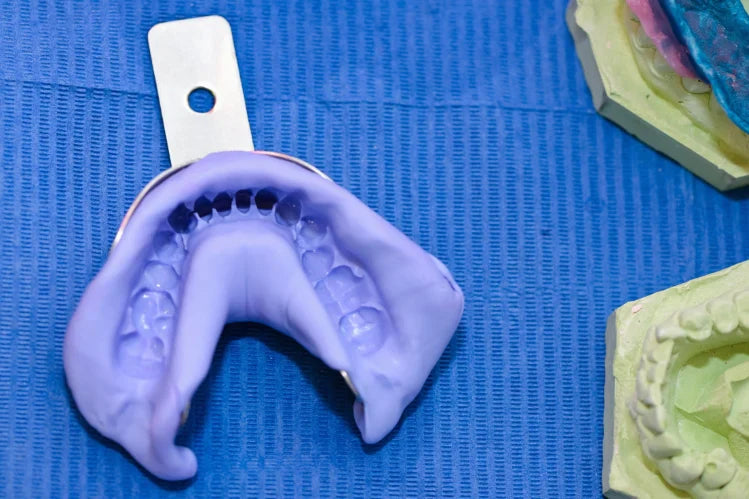
Table of contents
- Understanding Dental Impression Putty
- What Is the Use of Dental Putty?
- Common Pitfall Leading to Waste
- Misuse of Mixing Ratios
- Too Short a Mixing Time
- Inappropriate Timing of the Impression
- Polluted Putty
- Incorrect Tray Size
- Not Adhering to Directions
- Tray Overfilled or Under-filled
- Ignoring the Temperature
- How to make Dental Impressions: ALIGNERCO
- FAQs
The unsung hero of dental treatments is dental putty, a precise and flexible material essential for generating perfect tooth molds. Nevertheless, many customers experienced difficulty using their dental impression putty kits, resulting in material waste and heightened dissatisfaction. You will learn about typical hazards and recommended practices in this guide so you get the most out of your dental impression putty.
Understanding Dental Impression Putty
First of all, let me describe what dental putty is. It is one of the simplest features of modern dentistry which is famous for its essential role in various dental procedures.
This versatile product is often derived mainly from such compounds as silicones. It was designed to make precise and detailed prints of the gum and teeth of a patient.
When mixed together and applied to the model of a patient’s oral cavity, it sets hard into the impression of the patient’s teeth. This impression is important in molding a client suitable dental appliances that can easily be fitted and worn without much discomfort.
Dental putty is usually composed of two ingredients: There are various examples of observed chemical reactions that use a catalyst and a base. This putty cures the moment these two components are blended together, and there is no possibility of reaching its full potential if mixed separately. Due to this procedure, putty transforms to become a strong entity similar to rubber with the exact dimensions that it held when the procedure was done.
The first thing that should be considered regarding the putty is the fact that its consistence and texture is a crutial point. It has to be that leveled of soft that when applied you do not need a thick coating otherwise it will be sticky and does not apply smoothly without making the patient feel uncomfortable due to irritation caused by a small and well focused light.
It should not change shape when it is taken out of the mouth; otherwise it will affect the kind of dental appliance that is being fabricated.

What Is the Use of Dental Putty?
Dental putty is an important part of various processes, therapeutic to diagnostic. That so many uses are known underlines the versatility of the material and its relevance for practice in the dental field.
Making Dental Impression
Dental impression putty is mostly used in accurate formation of dental impression. They act as perfect casting plates through which appliances and dental restorations are produced and form the initial step of many dental treatments.
Using the putty on the patient’s dental arches is quite a delicate affair because the putty fills the contours of the teeth and gum line.
The value of the putty lies in the fact that once set, it provides an identical negative mould of the patient’s mouth which is needed for the accurate and exact construction of veneers, crowns, bridges, and other restoration devices.

Common Pitfall Leading to Waste
Misuse of Mixing Ratios
Incorrect mixing ratios are among the most frequent mistakes people make when using dental impression putty.The catalyst and base components must be combined exactly right for the putty to set properly. Mixing incorrectly can lead to variations in the putty's viscosity and curing time, resulting in an unusable impression.

Solution:
Make sure you follow the use of dental impression putty as indicated in the enclosed set of directions. Most of the time, the instructions will indicate the specific quantities of the base and catalyst that is to be used. To obtain accurate mixing, the surface should be clean and dry, tools should also be chosen correctly.
Expert Quote:
Prosthodontist Dr. Samantha Lee provides an expert quote, saying, "Precise blending is essential. The quality of the impression may be compromised by putty that is either too thick or too runny due to an excess or shortage of one of the ingredients."
Too Short a Mixing Time
Using the right ratios is not enough to prevent waste; make sure the putty is fully mixed. An uneven consistency from inadequate mixing can lead to incorrect impression settings in some areas.
Solution: Blend the putty until a consistent color and consistency are reached. Thorough kneading normally takes a few minutes. Before applying the putty, make sure there are no lumps or streaks.
Expert Quote: "Thorough mixing is essential," says dental materials expert Dr. Michael Chen. Any unmixed substance may cause the putty to become weak in certain places, giving an inaccurate impression."
Inappropriate Timing of the Impression
When taking a dental impression, timing is everything. The outcome may suffer if the putty is left in the impression tray for an extended period or not long enough.
Solution: Adhere to the setting times that your dental impression putty kit specifies. This usually takes two to three minutes for the putty to solidify before being removed. To guarantee accuracy, set a timer.
Expert Quote: Dental technician Dr. Emily Johnson states, "It's crucial to follow the suggested setup time. Inaccurate impressions may result from rushing or postponing the process."
Polluted Putty
Dental impression putty can get contaminated if it comes into touch with food, saliva, or other things. Both the imprint quality and the setting process might be impacted by contaminated putty.
Solution: Make sure the surfaces and equipment used to mix and handle the putty are dry and clean. If the putty has come into contact with any foreign objects, do not use it.
Expert Quote: Dental materials scientist Dr. Robert Martinez says to keep contaminants out of your impression putty. The impression can be compromised by even minute amounts of contaminants interfering with the setting process."
Incorrect Tray Size
Inaccurate imprints and wasted putty can result from using the incorrect size tray. Too small or too-large trays can cause your teeth to fit incorrectly and be incorrectly molded.
Solution: Make sure the tray you select covers your full tooth arch and fits comfortably in your mouth. Select the tray size that best suits your needs from the several sizes that most dental impression putty kits come with.
Expert Quote: Dr. Laura Green, an orthodontist, stresses the importance of choosing the appropriate tray size. A too-large tray can result in needless mess and waste, while a tray that is too small won't capture the entire arch."
Not Adhering to Directions
Too many people don't read and adhere to the directions that come with their dental impression putty kits. This can result in some problems, such as wrong setup timings and incorrect mixing.
Solution: Read and comprehend the directions that come with your dental impression putty kit carefully. To prevent common mistakes, carefully follow each step.
Expert Quote: "Always read the instructions thoroughly before starting," suggests dental hygienist Dr. Sarah Patel. Certain restrictions may apply to each kit, and failure to comply with them may result in less than ideal outcomes."
Tray Overfilled or Under-filled
Imperfect impressions and putty waste might result from either overfilling or underfilling the impression trays. A mess can be made with too much putty, and incomplete impressions can be made with too little.
Solution: Add just enough putty to each tray so that it covers the entire surface without spilling over. Pay attention to the directions on the appropriate putty quantity.
Expert Quote: "Using the correct amount of putty ensures a complete and accurate impression without wasting extra putty." This is explained by dental technician Dr. Natalie Fisher.
Ignoring the Temperature
The consistency and setting time of dental impression putty can be impacted by temperature. If the putty is used in extremely hot or cold temperatures, the impression may not turn out as intended.
Solution: Use dental impression putty in a room temperature setting as a solution. Work should not be done in extremely hot or cold temperatures as this can change the putty's consistency and setting.
Expert Quote: "The performance of dental impression putty is significantly influenced by temperature," says Dr. Alex Turner, a dental material scientist. To get the best outcomes, make sure you work in a controlled setting."
How to make Dental Impressions: ALIGNERCO
With the help of DIY dental impression putty from ALIGNERCO, you can quickly and simply make exact molds at home. It's easy to use, inexpensive, and convenient—perfect for custom aligners and retainers. Following are the instructions on how to make dental impressions at home.
- Mixing the Putty (45 seconds)
Put on the gloves and mix the base and catalyst for 25-30 seconds until they blend into a uniform color, showing no white streaks.

- Roll the putty (within 5 seconds)
Shape the blended putty into a ball, then use the palm of your hands to roll it into a 4-inch long sausage.

- Place the putty in the tray (within 5-10 seconds)
Use your fingers to spread it evenly in the tray and ensure there’s enough putty to capture the entire arch, molar-to-molar.

- Time to make an impression
Place the tray in your mouth (upper or lower arch) with the handle aligned under your nose. Bite into the center of the putty, avoiding the outer or inner walls.

Making the most of your dental impression putty and preventing needless waste is possible if you are aware of these typical issues and adhere to the above-recommended practices. A number of guidelines must be followed regarding mixing, timing, handling, and compliance in order to achieve the best impressions and ensure your dental appliances fit flawlessly.
FAQs
Q: What is dental impression putty?
A: A substance called dental impression putty is used to make imprints of your gums and teeth. It facilitates the process of taking the precise impressions required for bespoke dental products including crowns, retainers, and aligners.
Q: How should dental impression putty be mixed properly?
A: Combine catalyst putty and base in equal portions until the color is constant and homogeneous. Kneading this takes several minutes on average. Make sure you adhere to the detailed instructions included in your kit.
Q: Is dental impression putty reusable?
A: Dental impression putty isn't meant to be used more than once. It is imperative to achieve the correct impression the first time since once it has set, it cannot be undone.




